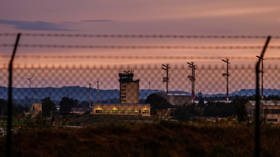World’s most powerful radio telescope COLLAPSES in Puerto Rico, after decades of hunting alien signals from space (PHOTOS)
The gigantic radio telescope at Arecibo Observatory in Puerto Rico has come crashing down, ending decades of extraterrestrial discoveries. The telescope was previously damaged, and was due to close.
The telescope’s 820-ton instrument platform broke free of its steel cables and crashed through the 1,000ft (305m) wide dish below on Monday night, the National Science Foundation (NSF) said in a tweet on Tuesday.
The instrument platform of the 305m telescope at Arecibo Observatory in Puerto Rico fell overnight. No injuries were reported. NSF is working with stakeholders to assess the situation. Our top priority is maintaining safety. NSF will release more details when they are confirmed. pic.twitter.com/Xjbb9hPUgD
— National Science Foundation (@NSF) December 1, 2020
The observatory had been closed since August, after an auxiliary cable snapped and tore a 100-foot gash in the dish. Following another cable breakage in early November, the NSF announced that its engineers were working on decommissioning the giant telescope.
Prior to its series of mishaps, funding for the telescope had been steadily reduced over the past decade, despite protest from the scientific community.
Photos taken from overhead showed the dish laid to waste, and littered with debris, while shots from ground level showed the telescope’s support towers still standing, but no longer supporting the massive instrument platform.
Dennis Vazquez via Facebook: He took these pictures of the collapse of the Arecibo Observatory. You can see the debris and the remains of the platform and the Gregorian Dome. pic.twitter.com/xneOGSVFYi
— Wilbert Andrés Ruperto (@ruperto1023) December 1, 2020
My whole life I’ve known of a magical facility in the Puerto Rican rainforest called Arecibo where scientists studied the universe and searched for messages. I’m so sad it’s gone.Before & after images from this morning’s tragic collapse of the telescope, taken by @DeborahTiempopic.twitter.com/99ZEwacYyI
— David Grinspoon (@DrFunkySpoon) December 1, 2020
Originally designed to track Soviet satellites and ballistic missiles in the 1950s, the Arecibo facility was eventually built in the early 1960s and turned its sights to space instead. Funded by the NSF and NASA, the telescope was at the forefront of astronomical discovery for more than five decades. It was used to determine the rotation period of the planet Mercury, to prove the existence of neutron stars, take the first direct image of an asteroid, and trace mysterious radio bursts from the furthest reaches of outer space.
Data from Arecibo has been used in the search for extraterrestrial life since the 1970s, and the telescope was used in 1974 to shoot the ‘Arecibo message’ 25,000 light-years into space. The message, a pattern of ones and zeros, included numbers, stick figures, chemical formulae, and a crude image of the telescope itself.
The telescope’s huge size and iconic construction saw it used in the final chase scene of the 1995 James Bond film ‘Goldeneye’.
Like this story? Share it with a friend!














